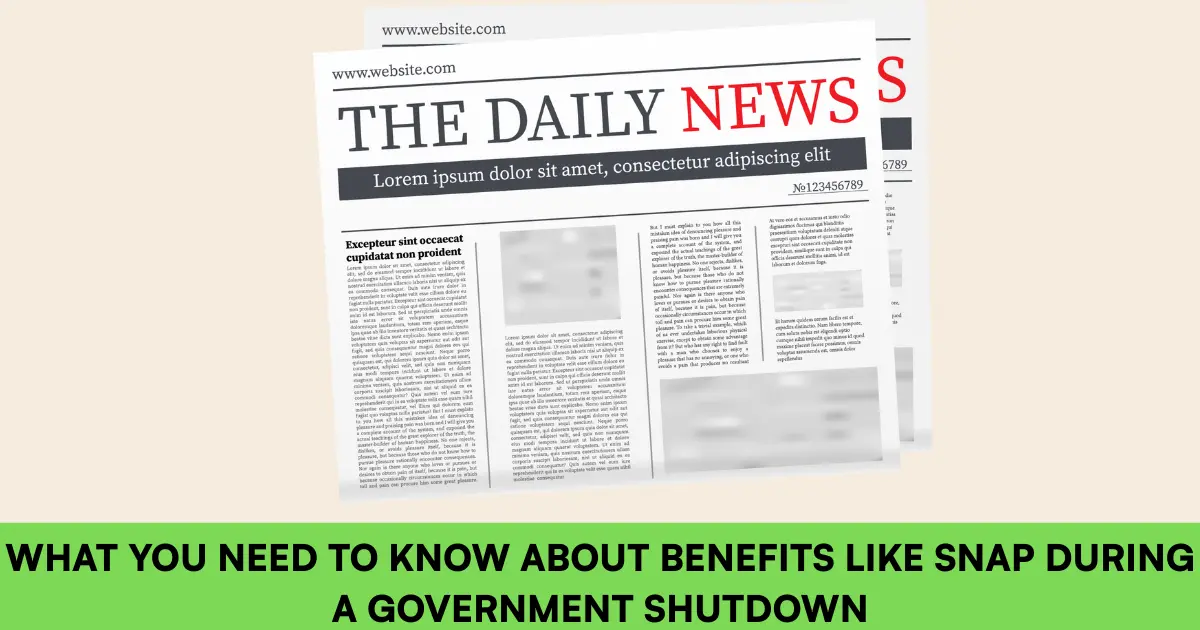As of October 2, 2025, political tensions in Congress have reignited fears of a government shutdown, reminiscent of the 35-day closure in 2018–2019. With funding deadlines looming, low-income families relying on programs like SNAP (food stamps) and WIC are understandably anxious. The good news? Benefits like SNAP are designed with safeguards to continue during short shutdowns, thanks to pre-allocated funding. However, longer disruptions could lead to delays, especially for WIC.
Drawing from expert analyses during the 2023 near-shutdown scare, this blog breaks down what happens to key nutrition benefits, potential risks, and tips to stay prepared. Remember, while SNAP’s structure offers resilience, the “One Big Beautiful Bill” (signed July 4, 2025) has already introduced $186 billion in cuts through 2034, making every dollar count.
How SNAP Benefits Fare During a Shutdown
SNAP, serving over 42 million Americans, is one of the most protected programs during funding lapses. Here’s why—and the caveats:
Benefits Continue Initially
- Pre-Obligated Funding: SNAP benefits for the month are typically “obligated” in the prior month, meaning they’re locked in before a shutdown hits. For example, if a shutdown starts on October 1, 2025, recipients would still get their full October benefits on schedule, as files are sent to EBT vendors in September.
- Reserve Funding: The USDA maintains a $6 billion contingency reserve, which can cover costs if a shutdown drags on past mid-month. This “carry-over” from the previous fiscal year acts as a buffer, allowing states to issue benefits without interruption.
Potential Delays for Future Months
- November Benefits at Risk: If the shutdown extends, the USDA must instruct states to transmit electronic files for the next month’s benefits (e.g., November files due mid-October). Without federal guidance, states may hesitate to proceed, fearing unreimbursed costs. In 2023, this nearly caused delays, but a last-minute deal averted it.
- State Hesitation: States rely on federal reimbursements and are reluctant to use their own funds without guarantees. A USDA memo has previously warned states they’d be liable without an appropriations bill.
In short, SNAP is built to weather short shutdowns (like the 2013 three-week event), but prolonged ones could disrupt issuances, hitting families hard amid rising food costs.
WIC: Higher Risk of Disruption
The Special Supplemental Nutrition Program for Women, Infants, and Children (WIC) supports 6.2 million participants with nutrition education and food vouchers for at-risk moms and kids under 5. Unlike SNAP, WIC’s funding is more vulnerable.
Short-Term Continuity, But Limited
- Initial Buffer: WIC has some carry-over funds to operate for a short period during a shutdown, potentially covering a few weeks of benefits. However, with a $1 billion budget shortfall already in play, this cushion is thin.
- Prioritization if Funds Run Low: Clinics might prioritize high-need groups like pregnant women and infants with nutritional issues, placing toddlers or lower-priority families on waitlists. In Wake County, North Carolina, a WIC official warned of turning away eligible families during the 2023 scare.
Why WIC Is More at Risk
WIC’s annual funding model lacks SNAP’s multi-year reserves, making it susceptible to lapses. During the 2018–2019 shutdown, some WIC agencies furloughed staff, delaying services—though benefits continued briefly.
Other Benefits at Risk During a Shutdown
While SNAP and WIC are nutrition-focused, a shutdown ripples across safety nets:
- TANF (Temporary Assistance for Needy Families): Similar to SNAP, benefits continue via pre-allocated funds, but administrative delays could slow new applications.
- Child Care Assistance: Programs like CCDF may face furloughs, disrupting subsidies for working parents.
- Head Start: Early education for low-income kids could see site closures if funding lapses.
- USDA School Meals: Free/reduced lunches continue via reserves, but reimbursements to schools might delay.
The USDA’s contingency plans (updated 2021) prioritize essential services, but non-essential staff furloughs could bottleneck support.
How the “One Big Beautiful Bill” Complicates Things
Even without a shutdown, the OBBBA’s SNAP cuts ($186 billion) and work requirements (80 hours/month starting 2026) strain families. A shutdown on top could exacerbate delays in benefit adjustments or appeals, especially in states like California facing $705 million in extra costs.
Tips to Prepare for a Shutdown
- Stock Up Wisely: Use current SNAP benefits for non-perishables before month-end, but avoid panic buying.
- Know Your Dates: Check your state’s issuance schedule (e.g., mid-month for California CalFresh) via BenefitsCal.com.
- Backup Plans: Connect with local food banks (Feeding America.org) or community kitchens. For WIC, contact your clinic early.
- Stay Informed: Follow USDA updates at www.fns.usda.gov or your state’s SNAP site (e.g., www.cdss.ca.gov for California).
- Advocate: Contact Congress (congress.gov) to push for funding resolutions.
Frequently Asked Questions (FAQs)
Will SNAP benefits stop during a shutdown?
No, initial benefits (e.g., October) continue due to pre-obligation, with $6 billion in reserves for longer periods. November could delay if USDA guidance lags.
What about WIC during a shutdown?
WIC has limited funds for short disruptions but risks waitlists for toddlers if extended, prioritizing pregnant women and infants.
How long can SNAP last without funding?
SNAP’s multi-year carry-over and reserves could sustain it for weeks to months, but state caution may cause earlier hiccups.
Does a shutdown affect school meals?
School lunches continue via reserves, but reimbursements to schools might delay, indirectly impacting families.
What if I’m on both SNAP and WIC?
Both have buffers, but WIC’s is shorter—stock up on formula/milk and monitor clinic alerts.
Wrapping Up: Stay Resilient
Government shutdowns are stressful, but SNAP’s design offers strong protection for the first month or more, while WIC needs quicker resolutions to avoid gaps. With the OBBBA already trimming benefits, proactive planning—like building a pantry and knowing local resources—is key.
Track updates from the USDA and your state agency, and remember: these programs are lifelines, built to endure disruptions. If you’re worried about eligibility, tools like the SNAP Eligibility Calculator can help you double-check. Hang in there—advocacy works, and benefits like SNAP have weathered storms before.

